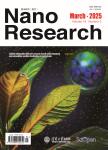Boron nitride nanotube growth via boron oxide assisted chemical vapor transport-deposition process using LiNO3 as a promoter
Boron nitride nanotube growth via boron oxide assisted chemical vapor transport-deposition process using LiNO3 as a promoter作者机构:National University of Science and Technology 'MISIS' Leninskiy prospect 4 Moscow 119049 Russia CRISMAT UMR 6508 CNRS-ENSICAEN 6BdMarechalJuin Caen 14050 France Institute for Materials Science (NIMS) Namiki 1 Ibaraki Tsukuba 3050044 Japan
出 版 物:《Nano Research》 (纳米研究(英文版))
年 卷 期:2015年第8卷第6期
页 面:2063-2072页
核心收录:
学科分类:081702[工学-化学工艺] 081704[工学-应用化学] 07[理学] 08[工学] 0817[工学-化学工程与技术] 0703[理学-化学] 070301[理学-无机化学]
基 金:supported by the Ministry of Education and Science of the Russian Federation (MES RF) (Increase Competitiveness Program of NUST "MISiS" in the frame of "Mega-Grant" award in the part of CVD synthesis of BN structures. O. I. L. gratefully acknowledges the financial support of the MES RF in the framework of Increase Competitiveness Program of NUST (MISiS) in the part of samples characterization using TEM and HRTEM. A. T. M and A. M. K. particular acknowledge the financial support from the MES RF
主 题:boron nit-ride nanotubes CVD lithium nitrate lithium borate BNNT growth mechanism
摘 要:High-purity straight and discrete multiwalled boron nitride nanotubes (BNNTs) were grown via a boron oxide vapor reaction with ammonia using LiNO3 as a promoter. Only a trace amount of boron oxide was detected as an impurity in the BNNTs by energy-dispersive X-ray (EDX) and Raman spectroscopies. Boron oxide vapor was generated from a mixture of B, FeO, and MgO powders heated to 1,150 ℃, and it was transported to the reaction zone by flowing ammonia. Lithium nitrate was applied to the upper side of a BN bar from a water solution. The bar was placed along a temperature gradient zone in a horizontal tubular furnace. BNNTs with average diameters of 30-50 nm were mostly observed in a temperature range of 1,280-1,320 ℃. At higher temperatures, curled polycrystalline BN fibers appeared. Above 1,320 ℃, the number of BNNTs drastically decreased, whereas the quantity and diameter of the fibers increased. The mechanism of BNNT and fiber growth is proposed and discussed.




